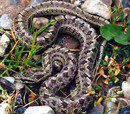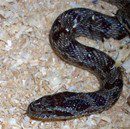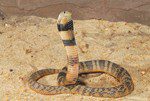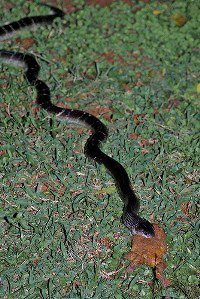
Patterned snake
The patterned snake is the most widespread species of all members of the genus Climbing snakes. It can be found on the territory of eastern Ukraine, further along the southern Russian border up to the Far East, as well as in China and Korea. The habitats of the snake are also very diverse: from the steppes and mountains to the shores of reservoirs and forests. All this makes the patterned snake one of the most convenient for keeping snakes. The color of the snake varies from brown and greenish to red and yellow. In any case, regardless of color, they are all characterized by four longitudinal stripes stretching along the entire body, which have a lighter color than the main background.
Contents
Naming in other languages
elaphe – crawling up, eluding, climbing snakes.
Dione – Dion. Dione’s climbing snake. (Dione is the daughter of Oceanus and Thetis, the mother of Venus and, according to the official Roman tradition, the ancestor of the Julius family).
Pallas snake, Dione snake, Steppes Ratsnake (English)
Steppennatter, Dione-Natter (German)
Classification
Kingdom: Animals.
Type: Chords.
Subtype: Vertebrates.
Class: Reptiles.
Order: Scaled.
Suborder: Snakes.
Family: Already shaped.
Genus: Climbing snakes.
Type: Patterned snake.
Inhabitation
 You can meet a patterned snake on the territory of Korea, Primorye, Mongolia, Northern China. On the territory of Central Asia (Kyrgyzstan, Tajikistan, Uzbekistan, Turkmenistan), Kazakhstan and Southern Siberia to Ukraine, Northern Iran, Afghanistan and Transcaucasia (Georgia, Azerbaijan, Armenia). Findings of this species of snakes are also known on some islands of the Caspian and Aral Seas.
You can meet a patterned snake on the territory of Korea, Primorye, Mongolia, Northern China. On the territory of Central Asia (Kyrgyzstan, Tajikistan, Uzbekistan, Turkmenistan), Kazakhstan and Southern Siberia to Ukraine, Northern Iran, Afghanistan and Transcaucasia (Georgia, Azerbaijan, Armenia). Findings of this species of snakes are also known on some islands of the Caspian and Aral Seas.
This is an environmentally friendly species. The snake adapts well to living in a variety of conditions in several natural zones: from deserts and steppes to mixed and coniferous forests. It can be found in floodplains and river valleys, in alpine meadows, on the outskirts of swamps, salt marshes, dunes, on rocky slopes, rising to a height of up to 3600 m above sea level. He quickly moves both along the branches of trees and on the ground, swims and dives superbly, including in sea water. As a shelter, it can use cavities under the roots of trees, hollows, cracks in the soil.
Often, the patterned snake settles near a person and often inhabits gardens, vegetable gardens, vineyards and crops, irrigated lands and rice fields.
Description
 The average life expectancy of a patterned snake is 9-10 years.
The average life expectancy of a patterned snake is 9-10 years.
The body coloration of this species is very diverse both in different populations and within one. The general background of the body: from above – grayish-brown, sometimes with a brown tint, with four brown longitudinal stripes (two of which are extended to the tail) and with blackish spots. On the upper surface of the head is a specific pattern that changes with age. A dark temporal stripe runs from the eyes to the neck. The belly is grayish or yellowish with a reddish speck. Sometimes dark spots. During the molting period, the color can change significantly, often becoming less contrasting.
It can reach a length of up to 1.5 meters. The tail, as a rule, does not exceed 17-30 cm. The preorbital shield can be partially divided from below. The width of the intermaxillary and internasal scutes is greater than their own height. The prefrontal brushes are in contact with the supraorbital brushes, and the only zygomatic brush has a trapezoid shape. There are two or three postorbital shields, 7-9 upper labials, 51-78 subcaudal ones, from 23 to 28 scales around the body. In males, the abdominal shields are 171 – 201, in females, 187 – 214. The anal shield is divided. The fourth or fifth labial touches the eye. Temporal scutes 2-3 and 3-4 in each of two vertical rows. On the sides of the body the scales are smooth, on the back with weak ribs and two apical pores.
Leads a predominantly daytime lifestyle. Wintering lasts from September-November to March-April.
As for the differences between the sexes in patterned snakes, in principle, females do not differ from males in color and size from each other. Males have a longer tail, with a characteristic thickening near the base, starting from the anus, it is cylindrical in shape, then turning into a cone. Females have a shorter tail, there is no thickening at the base, it is cone-shaped in shape. Sexual differences include a greater number of ventral scutes in females.
Among the enemies of the patterned snake are birds (in particular, the steppe eagle) and predatory mammals. Its ability to move quickly into cover or onto tree branches is a good defense. In case of danger, the tip of the tail vibrates, hitting hard objects, and emits a characteristic crackle.
The snakes are completely safe for humans. They are usually very calm, and their bites are completely harmless.
Food
The snake’s diet includes small mammals, birds, snakes, amphibians, fish, and insects. Eats chicks from bird clutches. At the same time, the egg swallows, opening its mouth wide. The shell is crushed by the lower processes of the vertebrae, pressing them on the dorsal wall of the esophagus.
The victim is swallowed from the head. The snake strangles the caught prey, squeezing it with the rings of its body, and swallows it only dead, after wetting it with saliva.
Cases of cannibalism have been recorded.
Reproduction
Sexual maturity in patterned snakes occurs at 2-3 years. Males mature earlier than females.
Mating takes place in April-May, although in a number of places (for example, in Primorye) the mating season is extended until June. Usually, the female lays her eggs in the forest litter or rotted grass near water bodies, in the dust of rotten trees. In laying from 5 to 24 eggs of various lengths (up to 16, 30 to 17, 50 mm.). The incubation period lasts about a month (more often it is reduced to almost two weeks, since the development of the embryos begins even in the female’s oviducts). Young individuals appear from July to September and have a length of about 24 cm and a weight of about 9 grams.
Newborn snakes molt after about a week and already begin to feed on newborn mice.
In a terrarium, after the snakes are taken out of wintering, they must be irradiated, as well as fed, adding preparations that contain vitamin E to food for 2-3 weeks. Next, females and males are planted next to each other. Copulation lasts quite a long time, about 2-3 hours. After mating, females lay eggs after 45-95 days. For masonry, you need to prepare a cuvette with sphagnum. The masonry itself is removed and placed at a temperature of 27-29 degrees in an incubator.
Content
 The small size of the patterned snake makes it a very convenient object for keeping in captivity. Because of the many color variations of this snake, it is very attractive to breeders.
The small size of the patterned snake makes it a very convenient object for keeping in captivity. Because of the many color variations of this snake, it is very attractive to breeders.
The snake should be kept in horizontal terrariums with dimensions of approximately 70x40x40 for one snake. It is best to keep them alone. In the terrarium, you will need to install a cuvette filled with water so that the snake can swim in it. The snake will also need it during periods of molting in order to get stuck in it. Large sawdust, gravel, tree bark are suitable as soil, although by and large soil is not required. Shelves, houses, etc. are suitable as shelters. In a warm corner of the shelter, a cuvette with sphagnum will need to be placed to maintain humidity. The snake can also burrow into it.
The optimum temperature is maintained using a thermal mat or a thermal cord. In the daytime, allowable temperature fluctuations are from 30 to 35 degrees. The temperature at night should be between 20 and 22 degrees. Heating at night at room temperature is optional. Sphagnum will need to be constantly kept moist and once a day, spray the terrarium with warm water.
During the period of activity of the snake, the duration of daytime heating, as well as the duration of daylight hours, is 12 hours. Irradiation with UV lamps continues throughout the day, these lamps can serve both for illumination and for irradiation. When irradiated, the use of erythemal lamps is still allowed – three times a day for 15 minutes.
Individuals grown in captivity do not react to the change of seasons in the same way as those caught in nature. Deep hibernation is not necessary for them, a slight decrease in temperature is enough, for about a month, and the cessation of feeding at this time. In captivity, snakes often make two clutches per year with an interval of 45 days.
At home, snakes should be fed with hamsters, quails and their eggs, laboratory mice. Feeding is done approximately once every five days, after the snake has digested the previous food and emptied itself well. Young snakes can be fed newborn mice once or twice a week. They grow quite quickly and after a couple of years they are already able to give offspring themselves. Mineral supplements, such as calcium or crushed eggshells, will need to be offered along with the food. You can add mineral water to the drinker, for example, Borjomi. About once a month, vitamin concentrated preparations can be offered with food, and as for balanced reptile feeding, they should be given strictly according to the instructions.
To keep a patterned snake at home, you will need the following equipment: an irradiation lamp, a lighting lamp, a daytime thermostat, a sprayer, a thermal cord or a thermal mat, a thermostat in a warm corner, a drinking bowl, tweezers. Of the additional equipment, it will not be superfluous: a night thermostat, a time relay and a thermometer in a cold corner. With good care, the patterned snake can live for more than ten years in captivity.
Additionally
Melanists are also found among representatives of this species. Uniformly colored individuals were previously described as independent subspecies, but further studies have established that these forms are only variants of the population variability of the species.
Collective clutches of snakes are known, reaching 120 eggs. True, most often only half of such clutches survive.
They contain patterned snakes in horizontal type terrariums. It is best to keep these snakes alone, as they are characterized by cannibalism. You will need a pool in the terrarium, which will provide the necessary level of humidity, and will also be used for swimming and drinking.
The patterned snake feeds on terrestrial vertebrates. At home, chicks of small birds, rat pups, laboratory mice are suitable for these purposes. In order to bring the snake’s diet as close as possible to the natural one, you can give the snake frogs and lizards. Small prey is swallowed whole by the snake, while large prey is strangled by body rings.
In captivity, this snake can live for about 10 years. The temperament of representatives of this species is quite docile, aggressive individuals are quite rare. Therefore, together with unpretentiousness, this feature of the snake allows us to recommend this snake as a candidate for the role of the first snake for beginner terrariumists.
Sources of
http://ru.wikipedia.org
http://www.ecosystema.ru
http://pets.academ.org
http://www.vitawater.ru
http://www.herpeto-volga.ru
http://dic.academic.ru
http://nuclearno.ru
Home





